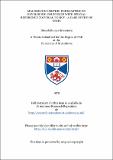Files in this item
Macroeconometric forecasting in developing countries with special reference to fiscal policy : a case study of India
Item metadata
| dc.contributor.advisor | Shaw, Graham Keith | |
| dc.contributor.author | Srivastava, Dinesh Kumar | |
| dc.coverage.spatial | (vii, 580) p. | en_US |
| dc.date.accessioned | 2018-07-13T08:54:06Z | |
| dc.date.available | 2018-07-13T08:54:06Z | |
| dc.date.issued | 1979 | |
| dc.identifier.uri | https://hdl.handle.net/10023/15347 | |
| dc.description.abstract | This work was undertaken with a view to construct a macroeconometric model for the Indian economy for purposes of forecasting and policy simulation. As a prelude to this exercise, we have surveyed available forecasting techniques, techniques of evaluation of forecasts and forecasting models and the issues concerning the use of macroeconometric models in the context of policy analysis. We have also considered specific issues and considerations relevant in the context of developing countries. As a second step towards providing a proper perspective to our model, and to derive useful guidelines, we have surveyed and reviewed existing macro-econometric models of the Indian economy. This survey concerns the models built by Narasimham, Choudhry, Krishnamurty, Krishnamurty-Choudhry, Marwah, Mammen, Agarwala, Pandit, Gupta, Bhattacharya and UNCTAD. We notice that an interesting variety of sectoral emphasis is offered in these models although in general they are all based on the IS-LM framework. As a part of the review of the existing models, we have re-estimated three models, viz., models by Choudhry, Marwah and Bhattacharya under common sample conditions and estimation techniques and have compared their forecasting performance against alternative autoregressive benchmark models. In general, the benchmark models do better but the performance of Bhattacharya and Marwah models, in their adapted versions, seems to be satisfactory. A common shortcoming of all these models is an underexploration of the fiscal sector of the economy. Generally, the government budget restraint has been ignored, the treatment of tax functions is highly aggregated and all government expenditure variables are treated as exogenous. Furthermore, the estimates in these models have become dated because of major data revisions. On these grounds and also as a part of continuing efforts towards building macroeconometric models for the Indian economy, we have specified, estimated and analysed a new model containing thirty four equations out of which eighteen are stochastic. Its special features are an endogenous treatment of government consumption expenditure, a disaggregated treatment of tax-revenue functions, an endogenous money-supply function and a distinction between the agricultural and non-agricultural sectors in terms of prices, outputs and investments. The model is estimated by mixed estimation procedures. In particular, two stage least squares with subsets of predetermined variables in the first stage and with first order autoregressive corrections in a few cases have been used. The model is used for forecasting and policy simulation. Its forecasting performance, within the sample period, and in a 'pseudo' forecast period is found to be satisfactory compared against 'naive' and 'not-so-naive' extrapolative benchmark models. Various policy simulations have been done and subsequently the model is used for conditional forecasting. We find that increases in government consumption expenditure have detrimental effects on real output, that changes in tax-rates and discount rates have very marginal impact on the system and that important policy changes relate to expenditure variables and government deficit financing. | en_US |
| dc.language.iso | en | en_US |
| dc.publisher | University of St Andrews | |
| dc.subject.lcc | HJ2928.S8 | |
| dc.subject.lcsh | Tax revenue estimating--India | en |
| dc.title | Macroeconometric forecasting in developing countries with special reference to fiscal policy : a case study of India | en_US |
| dc.type | Thesis | en_US |
| dc.contributor.sponsor | University of St Andrews | en_US |
| dc.type.qualificationlevel | Doctoral | en_US |
| dc.type.qualificationname | PhD Doctor of Philosophy | en_US |
| dc.publisher.institution | The University of St Andrews | en_US |
This item appears in the following Collection(s)
Items in the St Andrews Research Repository are protected by copyright, with all rights reserved, unless otherwise indicated.

